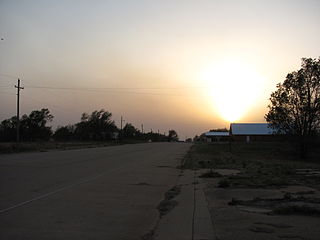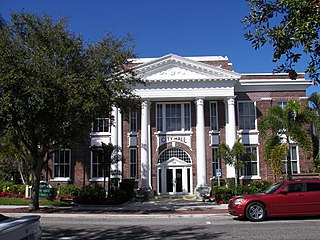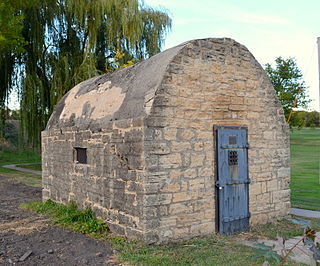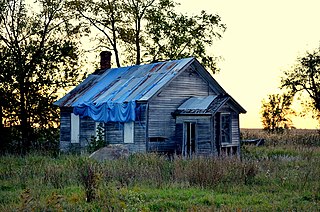
In the United States, a one-room jail is a type of jail with only one room, or cell.

In the United States, a one-room jail is a type of jail with only one room, or cell.
In some areas of the United States, a small, free-standing, one or two room jail building is known as a calaboose, meaning "dungeon" in Spanish. Calaboose were mainly used to incarcerate prisoners for minor crimes, such as drunkenness in public or fighting, or as a temporary holding cell for when a prisoner awaited transportation to a county jail. [6] [7]
Use of the calaboose was common throughout much of the United States in the 19th and early 20th centuries, and today surviving examples can be found in several states. Texas, with its large number of counties, has the highest concentration of historic calaboose jail buildings with over 100 known structures. Many calaboose have only a single cell, feature a curved or vaulted ceiling, and were constructed of solid concrete, although brick, stone and wooden examples also survive. [7]
A strap-iron jail is a type of open air jail made of strap iron bars. Basically a large metal cage with either one or two cells, strap-iron jails were commonly used in the United States in the mid to late 19th century. Several surviving examples exist in Texas. [15]

Texola is a town in Beckham County, Oklahoma, United States. The population was 43 at the time of the 2020 census, an increase over the 36 firgure from the 2010 census.

The Punta Gorda Residential District is a U.S. historic district located in Punta Gorda, Florida. The district is bounded by West Retta Esplanade, Berry Street, West Virginia Avenue and Taylor Street.

The Punta Gorda Atlantic Coast Line Depot is a historic Atlantic Coast Line Railroad depot in Punta Gorda, Florida, United States. It is located at 1009 Taylor Road.

Punta Gorda Lighthouse is a lighthouse in the United States, 12 miles (19 km) south of Cape Mendocino, California, within Humboldt County. Access is via a short hike from the end of a 4WD road. It is managed by the Bureau of Land Management.

Punta Gorda Airport is a public airport three miles east of Punta Gorda, in Charlotte County, Florida. It is owned by the Charlotte County Airport Authority and was formerly called Charlotte County Airport. The airport has mainly been used for general aviation, but has recently seen more scheduled airline service, with flights offered by Allegiant Air to fifty-one destinations.

The Dubuque County Jail is a historic building at 36 East 8th Street in Dubuque, Iowa, United States. Completed in 1858, the jail is an example of the uncommon Egyptian Revival style. It is architecturally a highly original work of John F. Rague, who also designed the 1837 Old Capitol of Illinois and the 1840 Territorial Capitol of Iowa. The building was designated a National Historic Landmark for its architecture in 1987. It served as a jail for more than a century, became a museum in 1975, and was converted into county offices in 2016.

The present Douglas County Courthouse is located at 1701 Farnam Street in Omaha, Nebraska, United States. Built in 1912, it was added to the National Register of Historic Places in 1979. Notable events at the courthouse include two lynchings and the city's first sit-in during the Civil Rights Movement. Five years after it was opened, the building was almost destroyed by mob violence in the Omaha Race Riot of 1919.

Bristol County Jail is a historic jail at 48 Court Street in Bristol, Rhode Island, and home to the Bristol Historical and Preservation Society.

Cardona Island Light is the only 6th order lighthouse in Puerto Rico with a cylindrical attached tower. The light is located on Cardona Island, a small island on the west side of the entrance to the harbor of Ponce, Puerto Rico. It was listed in the U.S. National Register of Historic Places on 22 October 1981.

Punta Gorda is a city located in Southwest Florida and is the county seat of Charlotte County, Florida, United States. As of the 2020 U.S. Census the city had a population of 19,471. Punta Gorda is part of the Sarasota-Bradenton-Punta Gorda Combined Statistical Area.

The Llano County Courthouse and Jail were erected separately, but added to the National Register of Historic Places in Texas on December 2, 1977 as one entry. The courthouse, located in the middle of Llano's historic square, was built in 1893. The exterior is made of sandstone, marble, and granite. The interior of the courthouse was damaged by fire in 1932 and again in 1951. It is still in use today by local government. The jail was erected in 1895, with the prisoner cells on the second and third floors, and the ground level solely for the office and living accommodations for the sheriff and his family. The jail was designated a Recorded Texas Historic Landmark 1979, Marker 9448. The courthouse was designated a Recorded Texas Historic Landmark 1980, Marker number 9446.

Delmar Calaboose is a historic one-room jail located in Delmar, Iowa, United States. The word calaboose is a corruption of the Spanish word calabozo, which means dungeon. The building was built for and used as a jail in frontier Iowa. The walls and roof of the one-story structure are composed of limestone and mortar. It was listed on the National Register of Historic Places in 1981.

Grand Mound Town Hall and Waterworks Historic District, also known as Hose house, pump house, is a historic district located in Grand Mound, Iowa, United States. It was listed on the National Register of Historic Places in 2001. The district is composed of two buildings and the town's water tower.

Wilson District No. 7 School, also known as the O'Meara Schoolhouse, is an historic structure located in rural Clinton County, Iowa, United States near the town of Delmar. The one-room school was listed on the National Register of Historic Places in 2004. The listing includes three structures: the former school building and two outhouses.

The Lu Verne City Jail, also known as the Old Calaboose, is a historic building located in Lu Verne, Iowa, United States. The city built its first jail in 1899. On May 6, 1912, they decided to build the current structure at the same location. They sold the old building, and C. Black completed the new 14-by-20-foot structure for $181.15. The single-story building is composed of concrete blocks that were cast to resemble cut stone. E.T. Barnum Ironworks of Detroit, Michigan provided the parts for the cells. The jail housed short-term offenders, usually those who were inebriated, committed petty crimes, and later hobos. The building also housed the fire department's hose cart. It served as a jail until 1934 when a new city hall was built. The jail cells were moved there at that time, and this building housed a welding shop sometime after that. The jail cells were returned to this building in 1975, and it is maintained by the Lu Verne Historical Society. It was listed on the National Register of Historic Places in 1992.

The Jeff Davis County Courthouse is located in the town of Fort Davis, the seat of Jeff Davis County in the U.S. state of Texas. The courthouse was constructed between 1910-1911 and added to the National Register of Historic Places in 2002. The Texas Historical Commission (THC) has also designated the building as a Recorded Texas Historic Landmark since 2000 and, along with the surrounding courthouse square, as a State Antiquities Landmark since 2003. The surrounding county and county seat, along with the nearby historic frontier fort at Fort Davis National Historic Site, are named after Jefferson Davis, who served as U.S. war secretary at the time of the establishment of the fort and the town, and who would later become president of the Confederate States of America during the Civil War.

Cuba City Jail is a historic jail located at Cuba, Crawford County, Missouri. It was built in 1908, and is a one-story, rectangular-shaped, concrete block jail structure. It consists of a primary guard space complete with desk and wood-burning stove and a rear cell room with pair of hanging iron bunks. The structure was in use until 1954 and today serves as a museum.
The Bronwood Calaboose is a calaboose built in 1900 in Bronwood, Georgia. It is a wooden jail, about 16 by 9 feet in plan, with a gable roof, built of heavy sawn timbers. It was listed on the National Register of Historic Places in 1982.